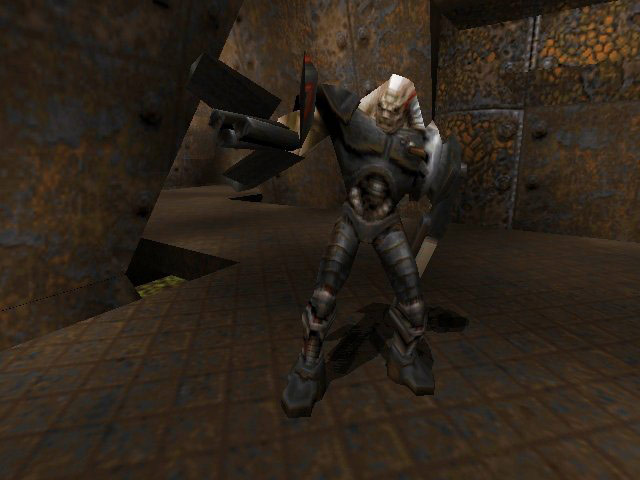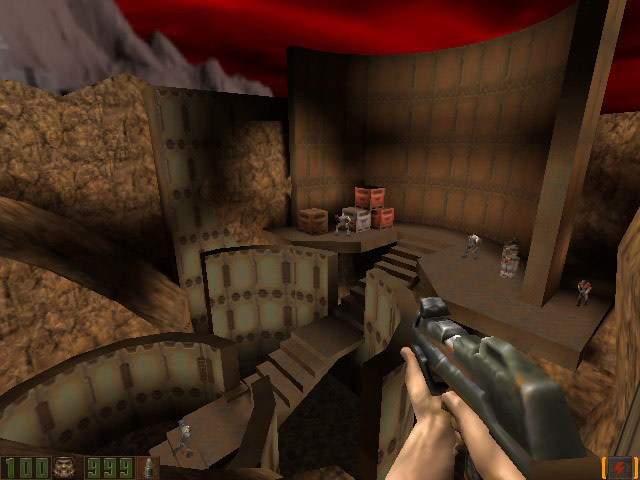The making of Quake 2
Tim Willits explains how the classic id shooter came to be.

But far from merely injecting their personalities into Quake II, those working on the title put everything they had into its development. Tim believes that youthful exuberance ultimately got the game over the finishing line, but he admits to cutting things a bit fine when it came to putting together the last remaining stage. “We put some crazy hours in, but we were all young. We made the hangar mission—which is not the greatest mission in the world—in the weeks before we shipped. It definitely came in hot!”
As well as a major shareholder in id Software, Activision was also Quake II’s publisher, and although the firm trusted id to deliver on time, it did have issues with the fact that the game required a fast PC that was preferably equipped with top-end graphics hardware. “Activision was concerned that you needed to have a graphics card,” Tim accepts, “that it was required for Quake II. But you know what? By the time Quake II came out everyone was pretty hot for the new graphics cards and CPUs. It was kind of the norm. Quake II was not the only game that you needed to buy the new cards for. The Epic guys were making great stuff, and there were lots of games companies who were making cutting-edge games, so it wasn’t really that big of a deal.”
You know what? We did a lot of fun things, and it was a good time to be in the industry; it was a good time for id Software.
Tim Willits
On Quake II’s release, it became clear that Tim’s assessment of the wider gaming market had been correct and that Activision’s anxieties had been unfounded. The game sold nearly a quarter of a million copies in its first few months on sale alone and garnered unanimous praise from the press, praise that still endures to this day, although Tim’s memories of the critical and commercial response to Quake II have faded over time. “I don’t remember. Did Quake II get good reviews?” Tim asks us. “I always tried to focus on the game. I really loved working on Quake II, and I felt personally that I had grown a lot as a designer. We had such fun making that game, and there was so much talent. We were more focused, we were more design-driven and we all liked each other. So it really showed in the product, you know. Quake II was a labour of love that I was very proud of.”
In the years that followed, id licensed the engine that had powered Quake II for use in a number of popular third-party titles, each of which Tim viewed with pride. “They were all great,” Tim exclaims. “I loved all of the Quake II engine games. We were blessed to work with teams like Raven, Ritual and Activision that took the Quake II engine and did amazing things with it. And look at Half-Life, which changed the industry, I mean, it was awesome. They felt like id games. I always brag about the origins of those games and how they were based on id Software technology. We were always a small company, so we had a small foot. But we had a giant footprint, and that was the software—that was always a point of pride.”
When looking back at Quake II, Tim offers an equally enthusiastic appraisal, with his one caveat being his conviction that the much-loved id FPS should’ve had a different name and should’ve been the first chapter in a new franchise. “Well it’s still fun,” Tim notes, “there’s still a ton of people that really love it. We made the rockets slower than Quake, and some people are sad about that. Some people love Quake II’s speed, some people prefer Quake’s speed; it just depends on which Quake you played first. Quake II should have been called something different in my personal opinion—I will say that. But you know what? We did a lot of fun things, and it was a good time to be in the industry; it was a good time for id Software. And then, of course, the greatest gun ever was the railgun. Quake II was the culmination of the people that worked on it, because everyone was pretty unique and different in the team, and we really tried to be pretty flat in our design structure. So it was fun to work on the game.”

How Quake II compares on other systems
Mac
3D graphics cards for Macs didn’t become common until the late-Nineties, so it’s unsurprising that the Mac Quake II arrived two years after the PC release. The wait was worth it, though, as the Mac version is all but identical to the original. So much so that Mac and PC Quake II owners can face off in online deathmatches.
N64
Essentially a reworking of the PC original designed to better suit the N64’s reliance on cartridge-based storage, Quake II on Nintendo’s system features stripped-back levels coupled with simplified systems. N64 Quake II does feel like the original, however, as it shares its aesthetics and game design.
Keep up to date with the most important stories and the best deals, as picked by the PC Gamer team.
PlayStation
Slightly less impressive than the N64 version in terms of speed and visuals, the PlayStation Quake II does convert levels from the Nintendo iteration nicely. Like the N64 port, the PlayStation Quake II has splitscreen multiplayer, it also adapts stages from the original game and boasts two exclusive Strogg opponents.
Amiga
By 2002, the five-year-old Quake II was looking a little long in the tooth compared to cutting-edge FPS titles, but id’s release of its source code the year prior convinced Hyperion Entertainment to release an Amiga version. The end result is close to the original, but it requires a fast CPU and accelerated graphics card.

Quake II's best stages
Processing Plant
Built to render down captured marines into a disgusting slime that the Strogg feed on, the processing plant houses seven macabre machines sited on a circular route. Besides one tank commander, your mission to disable the machines is met with low-level opposition, although surprise attacks are common, so stealth tactics are advised.
Big Gun
The big gun mission’s solid middle section pales in comparison to the epic boss fight at its start and the heart-stopping race to safety at its finale. The mission’s airborne boss—the Hornet—requires you to pepper it with heavy gunfire followed by taking cover when it returns fire, while the mission’s end-of-level escape leaves no margin for error.
Inner Hangar
The objective of storming the inner hangar is to close its doors and ground the Stroggs’ spacecrafts. As the hanger is heavily guarded a slow, steady approach is recommended, particularly when negotiating its floating blocks and giant cogs. The Hornet guarding the hanger entrance is best tackled from a high vantage point.
Outlands
Bar for a gun emplacement near its start, whose operator can be taken out with a ranged weapon, the outlands mission is a high-tempo test of marksmanship. Following a hill pass, you cut across bridges and through caves while avoiding barracudas. Finally, you activate the air strike marker, take cover and then make your way to the exit.
Outer Courts
Deep within the outer courts there’s a data spinner that’s required to shut down a Strogg communication system. The route to your target begins with a dangerous, stomach churning cliff-edge walk, after which the going gets tough, so have your biggest guns ready. The spinner itself is located after a disorienting underwater section.


